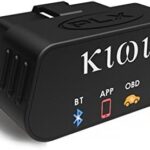In the automotive world, diagnosing car problems has evolved significantly. Gone are the days of solely relying on tailpipe emissions tests. Modern vehicles are equipped with sophisticated On-Board Diagnostics (OBD) systems, and mechanics now utilize scan tools that plug directly into your car’s OBDII port to assess its health. A key component of this diagnostic process is OBD2 Mode 6, a somewhat mysterious yet incredibly useful feature.
See also: What is OBD II? History of on-board diagnostics
Decoding OBD2 Mode 6
Since 1998, light-duty vehicles have incorporated OBDII systems, enabling external devices to request specific data from the vehicle’s computer. The OBDII standard includes nine modes, with Mode 6 dedicated to “test results and other component/system monitoring.” Essentially, Mode 6 is where your car’s computer stores the results of self-tests performed on various systems and components to ensure they operate within acceptable parameters.
These self-tests cover critical emission-related components such as:
- Oxygen sensors: Monitoring the oxygen levels in the exhaust to ensure optimal fuel combustion and catalytic converter efficiency.
- Catalytic converter: Reducing harmful pollutants in exhaust gases.
- Evaporative Emission Control System (EVAP): Preventing fuel vapor release into the atmosphere.
Mode 6 acts as a repository for the data generated from these tests. When a mechanic connects a scan tool to your OBDII port and requests Mode 6 data, they can access these test results. This information is crucial in determining whether your vehicle meets emission standards and identifying potential issues.
The Practical Benefits of Mode 6
While primarily used by mechanics, OBD2 Mode 6 offers valuable insights for vehicle owners as well. Think of it as an early warning system for your car’s health, potentially signaling problems before the check engine light even illuminates.
Mode 6 can be considered a “crystal ball” for detecting subtle performance degradations. If a component begins to malfunction or operate below standard, the corresponding Mode 6 test result will likely indicate a failure before a fault code triggers the check engine light. This proactive insight allows for early diagnosis of issues that might not be severe enough to immediately activate the warning light but are nonetheless affecting your vehicle’s performance or emissions.
For instance, consider a scenario where a vehicle experiences a gradual decline in fuel economy. While this could be attributed to normal wear and tear, investigating Mode 6 might reveal a failing Catalyst Monitor Bank 1 test. This early indication could precede a pending fault code like P0420 (Catalyst System Efficiency Below Threshold (Bank 1)), allowing for timely intervention and preventing more significant problems down the road.
Understanding the Limitations of Mode 6
Despite its benefits, OBD2 Mode 6 data can be complex and challenging to interpret. The specific components tested and the tests performed can vary significantly depending on the vehicle’s make, model, and year. Some vehicles might have extensive Mode 6 data with numerous tested components, while others might have a more limited set of tests.
Furthermore, deciphering the meaning of Mode 6 test results can be difficult. The descriptions of tests and components are not always standardized and can be cryptic. Even when you can identify a failing test, understanding the exact nature of the problem and the appropriate repair can require further investigation and expertise. Vehicles may also employ different measurement units and testing methodologies for the same component, adding another layer of complexity to interpretation. One vehicle might use voltage readings for a test, while another might use current readings.
Despite these challenges, OBD2 Mode 6 remains a powerful diagnostic tool. While it might not always provide a definitive diagnosis on its own, it serves as an excellent starting point for troubleshooting and should be considered a valuable asset in any diagnostic toolkit. Automotive experts are continuously working to decode and standardize Mode 6 data, making it more accessible and user-friendly in the future.

